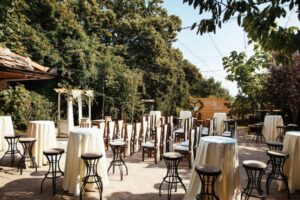Architect in the Bahamas: Innovation and Sustainability in Caribbean Design

New trends in residential and tourism architecture in the Bahamas
The architecture scene in the Bahamas is going through a transformation driven by innovation, sustainability, and a constant search for solutions that respect the Caribbean environment. Being an architect in the Bahamas means facing unique challenges related to climate, culture, and nature, while designing spaces that are both functional and visually appealing. The rise in tourism and the growing demand for high-end residences have sparked significant changes in how design studios work and set priorities. Out of this, new trends are emerging that blend local traditions with contemporary techniques to create projects that interact naturally with the island landscape.
Today’s residential and tourism projects pay special attention to user experience and the balance between indoors and outdoors, always seeking to maximize sea views and natural ventilation. Architects are incorporating patios, terraces, and breezeways that promote air circulation and cut down on the need for artificial cooling. They’re also choosing color palettes and materials that fit both Caribbean aesthetics and the durability required against salty, humid conditions. These design choices aim to improve residents’ quality of life while reducing the environmental footprint of new builds.
Sustainable architecture: commitment to the Bahamian environment
Sustainability is at the heart of architectural practice in the Bahamas, where preserving biodiversity and natural resources is a top priority. The use of local, recycled, or low-impact materials has become a common strategy to minimize ecological impact while also supporting a circular economy on the islands. Projects increasingly integrate passive design strategies such as cross ventilation and natural daylighting to reduce energy use and improve indoor comfort. These go hand in hand with active measures like photovoltaic solar systems to boost efficiency and energy independence.
Collaboration between architects, engineers, and landscape designers is key to finding solutions that are sensitive to the environment. Many projects now include rainwater collection systems, natural greywater treatments, and waste management strategies that help protect fragile ecosystems. Climate change adaptation and risk mitigation rely on integrated approaches, such as elevated foundations, natural barriers, and green corridors that protect local flora and fauna. In this way, architecture in the Bahamas is striking a balance between technical innovation and respect for the land.
The impact of local culture on the work of an architect in the Bahamas
Bahamian culture—with African, British, and American influences—gives architecture in the islands a distinct personality that shapes both aesthetic and functional decisions. For an architect in the Bahamas, capturing the cultural essence of the place means reinterpreting traditional elements like verandas, pitched roofs, and vibrant colors in a contemporary way. These references create spaces that encourage community life, cross ventilation, and a close connection with the marine environment. Local crafts and native materials add identity to interiors and support project sustainability.
This cultural integration shows up in both private homes and tourism developments, where design narratives aim to tell the story of the place and provide authentic experiences for visitors and residents. Architects often work directly with local communities to understand traditions, customs, and real needs—allowing them to propose solutions that respect heritage while improving livability. This participatory approach encourages communities to take ownership of the spaces and helps preserve cultural elements within new projects.
Climate challenges: solutions for resilient building
Designing in the Bahamas means accounting for extreme weather risks like hurricanes, strong winds, and constant exposure to humidity and salt. Architectural responses include selecting corrosion-resistant materials, creating sealed building envelopes, and applying construction methods that lower the risk of structural damage. Building codes have become stricter, requiring projects to meet high safety and durability standards. This pushes professionals to stay updated on best practices and new technologies. Prevention and resilience are guiding principles at every stage—from site analysis to long-term maintenance.
Common strategies include elevated foundations, reinforced anchoring systems, and high-performance windows that minimize leaks. Digital modeling and simulation tools help anticipate how buildings will behave under different climate scenarios, improving material and construction decisions. On a broader scale, urban planning and infrastructure siting take into account topography and ocean currents to reduce vulnerabilities. These combined practices make buildings safer and help ensure economic activity can continue even after extreme events.
Architecture for luxury tourism in the Bahamas
Luxury tourism calls for projects that deliver unique experiences while maintaining comfort and sustainability. High-end resorts and villas are designed as spaces that harmoniously integrate architecture, service, and the natural environment. For an architect in the Bahamas, this means finding the right balance between privacy, privileged views, and connection to the sea. Choosing premium, durable materials and construction systems is essential to guarantee long-lasting quality and protect investments.
Working hand in hand with tourism operators and hospitality brands allows for projects that combine iconic design with demanding service standards. Interior design enhances the overall concept with solutions that emphasize comfort, resilience, and a look that reflects the local context. The guest experience is carefully planned from arrival through their stay, with fluid transitions between indoor and outdoor spaces, natural ventilation, and access to amenities that highlight the natural setting. This holistic approach strengthens the competitiveness of the Bahamas in the international luxury market.
Design process and international collaboration
International collaboration has expanded the creative and technical possibilities of architecture in the Bahamas, enabling knowledge exchange from different parts of the world while tailoring solutions to local conditions. The design process begins with a detailed site analysis—including geotechnical, climatic, and sociocultural studies. Based on this, architects create conceptual proposals that go through technical reviews, permits, and legal checks, always maintaining open communication with clients and communities. Transparency and coordination across disciplines are critical to reducing risks and optimizing resources.
Tools like BIM and virtual reality make it easier for international teams and remote clients to collaborate, speeding up decision-making and improving precision during execution. These platforms allow for material simulations, energy performance testing, and detailed construction planning. The result of adopting such collaborative processes is greater efficiency and projects that stay true to the original vision. Global cooperation enriches the technical and creative resources available for each commission.
Training and specialization of architects in the Caribbean context
Architects working in the Bahamas are trained not only in technical knowledge but also in practical skills specific to tropical climates and resource management. Educational programs and postgraduate courses offer training in energy efficiency, water management, and hurricane-resistant design, among other areas. This type of specialization helps professionals tackle real-world challenges on the islands—from material selection to urban design. Specialized training equips architects with the tools to create sustainable, context-sensitive projects.
Ongoing professional development is essential, so participation in conferences, workshops, and networking opportunities is common. These activities expose professionals to international standards, technological innovations, and successful case studies applicable to the Caribbean context. Continuous education also supports the growth of practice-based communities where solutions are shared and improvement is encouraged. Altogether, this learning ecosystem raises the quality and competitiveness of Bahamian architecture.
Digital innovation in Bahamian architecture
Digitalization is reshaping how architectural projects are designed and executed in the Bahamas. The use of 3D modeling software and collaborative platforms allows for greater precision and visualization before construction begins. These tools streamline coordination between all stakeholders, reduce mistakes, and optimize costs by anticipating construction conflicts. Clients also benefit from realistic simulations that help them make better decisions early on.
Emerging technologies—like integrated sensors and smart management systems—are also finding their way into buildings that prioritize efficiency and comfort. Home automation for cooling, lighting, and energy consumption makes it possible to adjust resources in real time, improving the operational sustainability of buildings. The combination of climate-sensitive design and smart tech creates adaptive solutions that respond to changing environmental conditions, enhancing both functionality and user experience.
Success stories and future perspectives
In recent years, several projects in the Bahamas have stood out for blending creativity, sustainability, and adaptability, led by both local and international studios. These success stories showcase innovative construction methods with strong environmental commitments, creating models that could be replicated across the Caribbean. Each project demonstrates the potential for high-quality architecture that respects cultural identity while protecting marine and terrestrial ecosystems. Observing and analyzing these projects provides valuable lessons for future initiatives.
Looking forward, architecture in the Bahamas seems headed toward more personalized, multi-system solutions where technology and environmental respect are central. The push for resilient, low-impact projects is expected to spark new materials and construction methods adapted to extreme climates. Knowledge exchange between local and international professionals, along with circular economy practices, will further strengthen long-term sustainable development. For those interested in exploring different approaches and examples, it’s worth checking out specialized references, including the work of bahamas architecture
that documents contemporary projects in the region.
The role of the architect in the Bahamas today
The architect in the Bahamas wears many hats: designer, technician, social mediator, and guardian of the natural environment. This versatile role is essential in a society that seeks development without losing its cultural identity and heritage. Today’s practice demands both cultural sensitivity and technical expertise to deliver resilient, livable solutions. The resulting projects aim to harmonize tradition and modernity, creating spaces that meet housing, tourism, and community needs.
Practicing architecture on the islands blends creative vision with regulatory rigor and environmental care—requiring an integrated, pragmatic approach. Professionals strive to create spaces that promote well-being, safety, and efficiency, while prioritizing material quality and climate-responsive design. Attention to construction details and long-term operability is part of this commitment. In this sense, the architect is a key player in shaping a built environment that is sustainable and representative of Bahamian culture.
Opportunities for the new generation of architects
Current conditions create exciting opportunities for young architects looking to specialize in island contexts and tropical climates. The challenges linked to climate change and tourism demand open the door for fresh, creative, and technical approaches—encouraging innovation and entrepreneurship. The growing need for sustainable, efficient projects supports the rise of new studios that integrate technology with context-aware design. For the new generation, this is a chance to bring fresh, relevant solutions to the archipelago’s development.
Access to digital tools, professional networks, and exchange platforms helps young talent get involved in both local and international projects. Collaborating with communities and public administrations provides opportunities to take part in socially and environmentally impactful initiatives. Technical knowledge combined with cultural sensitivity will be a key differentiator for those who want to leave their mark on Bahamian architecture. In this way, the Bahamas are positioning themselves as an attractive setting for professional growth and responsible architectural experimentation.
Relacionados
Las bolsas de valores
Las mejores frases del mundo
En que criptomoneda invertir
American express black card
Cursos universitarios online gratuitos
Paginas para escribir historia
Whatsapp desde el ordenador
Los idiomas mas importantes del mundo
The walt disney company
Canciones en ingles actuales
Servicio de envio de paquetes
Como hacer que tu ordenador vaya mas rapido windows 10
Como aprender a hablar ingles
Que libro me leo ahora
Plan de negocios emprendedores
App para escribir textos
Cosas para vender facil y rapido
App para controlar gastos






